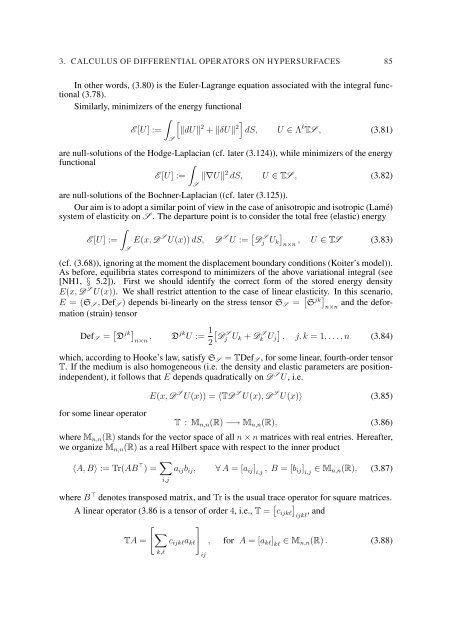EQUATIONS OF ELASTIC HYPERSURFACES
EQUATIONS OF ELASTIC HYPERSURFACES
EQUATIONS OF ELASTIC HYPERSURFACES
Create successful ePaper yourself
Turn your PDF publications into a flip-book with our unique Google optimized e-Paper software.
3. CALCULUS <strong>OF</strong> DIFFERENTIAL OPERATORS ON <strong>HYPERSURFACES</strong> 85<br />
In other words, (3.80) is the Euler-Lagrange equation associated with the integral functional<br />
(3.78).<br />
Similarly, minimizers of the energy functional<br />
∫<br />
E [U] :=<br />
S<br />
[‖dU‖ 2 + ‖δU‖ 2 ]<br />
dS, U ∈ Λ l TS , (3.81)<br />
are null-solutions of the Hodge-Laplacian (cf. later (3.124)), while minimizers of the energy<br />
functional<br />
∫<br />
E [U] := ‖∇U‖ 2 dS, U ∈ TS , (3.82)<br />
S<br />
are null-solutions of the Bochner-Laplacian ((cf. later (3.125)).<br />
Our aim is to adopt a similar point of view in the case of anisotropic and isotropic (Lamé)<br />
system of elasticity on S . The departure point is to consider the total free (elastic) energy<br />
∫<br />
E [U] := E(x, D S U(x)) dS, D S U := [ Dj S U k , U ∈ TS (3.83)<br />
]n×n<br />
S<br />
(cf. (3.68)), ignoring at the moment the displacement boundary conditions (Koiter’s model)).<br />
As before, equilibria states correspond to minimizers of the above variational integral (see<br />
[NH1, § 5.2]). First we should identify the correct form of the stored energy density<br />
E(x, D S U(x)). We shall restrict attention to the case of linear elasticity. In this scenario,<br />
E = (S S , Def S ) depends bi-linearly on the stress tensor S S = [ S jk] and the deformation<br />
(strain)<br />
n×n<br />
tensor<br />
Def S = [ D jk] n×n , Djk U := 1 2[<br />
D<br />
S<br />
j U k + D S k U j<br />
]<br />
, j, k = 1, . . . , n (3.84)<br />
which, according to Hooke’s law, satisfy S S = TDef S , for some linear, fourth-order tensor<br />
T. If the medium is also homogeneous (i.e. the density and elastic parameters are positionindependent),<br />
it follows that E depends quadratically on D S U, i.e.<br />
for some linear operator<br />
E(x, D S U(x)) = 〈TD S U(x), D S U(x)〉 (3.85)<br />
T : M n,n (R) −→ M n,n (R), (3.86)<br />
where M n,n (R) stands for the vector space of all n × n matrices with real entries. Hereafter,<br />
we organize M n,n (R) as a real Hilbert space with respect to the inner product<br />
〈A, B〉 := Tr(AB ⊤ ) = ∑ i,j<br />
a ij b ij , ∀ A = [a ij ] i,j<br />
, B = [b ij ] i,j<br />
∈ M n,n (R), (3.87)<br />
where B ⊤ denotes transposed matrix, and Tr is the usual trace operator for square matrices.<br />
A linear operator (3.86 is a tensor of order 4, i.e., T = [ c ijkl<br />
]ijkl , and<br />
[ ]<br />
∑<br />
TA = c ijkl a kl , for A = [a kl ] kl<br />
∈ M n,n (R) . (3.88)<br />
k,l<br />
ij

















